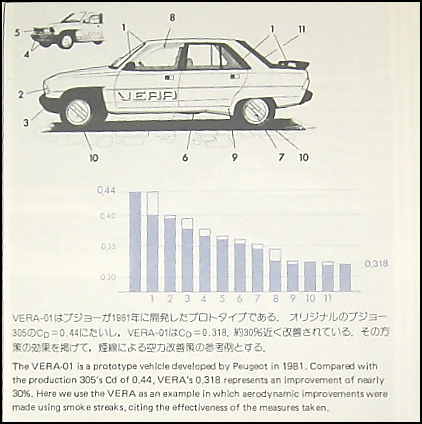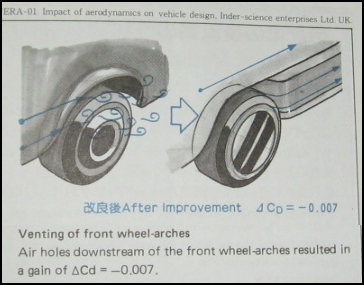 02-10-2011, 06:01 PM
02-10-2011, 06:01 PM
|
#1 (permalink)
|
|
Master EcoModder
Join Date: Nov 2010
Location: Atlanta
Posts: 403
Thanks: 1
Thanked 37 Times in 28 Posts
|
Cd by %
Been looking for some info on what parts of the car generate what %/ level of drag, to sort of get an idea what to work on first, ie- largest drag components.
Have several planned but a chart would be nice.
|
|
|

|
 Today Today
|
|
|
|
 Other popular topics in this forum...
Other popular topics in this forum...
|
|
|
|
 02-10-2011, 06:57 PM
02-10-2011, 06:57 PM
|
#2 (permalink)
|
|
Pokémoderator
Join Date: Dec 2007
Location: Southern California
Posts: 5,864
Thanks: 439
Thanked 532 Times in 358 Posts
|
BHarvey -
This *might* help. I made an album of all the pictures in the Car Styling magazine of this Peugeot VERA :
Fuel Economy, Hypermiling, EcoModding News and Forum - EcoModder.com - cfg83's Album: 1981 Peugeot Vera

The magazine didn't number the mods, so the numbers I inserted are my best guess of the mods in relation to the bar graph. I couldn't find a mod that "matched" #7, so it's a mystery as far as I can tell.
I just noticed that this appears to be the source of the drawings :
G. Roussillon: Aerodynamic optimization of the Peugeot VERA-01. Impact of aerodynamics on vehicle design. Inder-science enterprises Ltd. UK.
Also keep in mind that some of these are *not* relevant to today's cars, while others are proven. For instance, the 1st gen Honda Insight used this type of wheel-well in the front :

CarloSW2
Last edited by cfg83; 02-11-2011 at 05:53 PM..
|
|
|

|
|
The Following 3 Users Say Thank You to cfg83 For This Useful Post:
|
|
 02-11-2011, 05:49 PM
02-11-2011, 05:49 PM
|
#3 (permalink)
|
|
Master EcoModder
Join Date: Jan 2008
Location: Sanger,Texas,U.S.A.
Posts: 16,496
Thanks: 24,517
Thanked 7,436 Times in 4,817 Posts
|
stickys
BHarvey,have you checked out the stickys here at the aero forum? They might have just what you're looking for.
|
|
|

|
 02-11-2011, 06:44 PM
02-11-2011, 06:44 PM
|
#4 (permalink)
|
|
Master EcoModder
Join Date: Jan 2010
Location: Oregon
Posts: 471
Thanks: 15
Thanked 65 Times in 48 Posts
|
According to some of the Cd changes listed on the Vera, my Cd should be around .28.
__________________
In Reason we Trust

|
|
|

|
 02-14-2011, 09:03 AM
02-14-2011, 09:03 AM
|
#5 (permalink)
|
|
aero guerrilla
Join Date: Oct 2008
Location: Warsaw, Poland
Posts: 3,763
Thanks: 1,364
Thanked 762 Times in 482 Posts
|
Here is what I found in Piechna's book:
According to Carr ([1], nice last name in this field of research, btw), for modern cars the coefficient of surface drag is around 0.08. For a mid-sized passenger car the coefficient of lift is 0.15, which implies that the edge vortex drag coefficient is 0.01 (assuming that coefficient k in Carr's formula is equal to 0.5).
Based on these assumptions, a typical drag coefficient of Cx=0.30 could be decomposed in the following ways:
| . | delta Cx (Barnard, [2]) | delta Cx (Katz, [3]) | | Surface drag | 0.08 | 0.04-0.05 | | Air pressure drag | 0.10 | 0.00-0.45 | | Wheels | 0.08 | - | | Engine cooling | 0.03 | 0.00-0.06 | | Internal airflow, ventilation | - | 0.00-0.05 | | Edge vortices | 0.01 | 0.00-0.60 | | Total | 0.30 | - |
[1] Carr G.W., Potential for aerodynamic drag reduction in car design, Impact of Aerodynamics on Vehicle Design, Proc, International association for Vehicle Design: Technological Advances in Vehicle Design, SP3, ed. Dorgham M.A., 1983, pp.44-56.
[2] Barnard R.H., Road Vehicle Aerodynamic Design, Longman, 1996.
[3] Katz J., Race Car aerodynamics, Robert Bentley Automotive Publishers, 1995.
__________________
e·co·mod·ding: the art of turning vehicles into what they should be
What matters is where you're going, not how fast.
"... we humans tend to screw up everything that's good enough as it is...or everything that we're attracted to, we love to go and defile it." - Chris Cornell
 [Old] Piwoslaw's Peugeot 307sw modding thread
[Old] Piwoslaw's Peugeot 307sw modding thread
|
|
|

|
|
The Following User Says Thank You to Piwoslaw For This Useful Post:
|
|
 02-14-2011, 04:57 PM
02-14-2011, 04:57 PM
|
#6 (permalink)
|
|
Master EcoModder
Join Date: Jan 2008
Location: Sanger,Texas,U.S.A.
Posts: 16,496
Thanks: 24,517
Thanked 7,436 Times in 4,817 Posts
|
other values
Quote:
Originally Posted by Piwoslaw

Here is what I found in Piechna's book:
According to Carr ([1], nice last name in this field of research, btw), for modern cars the coefficient of surface drag is around 0.08. For a mid-sized passenger car the coefficient of lift is 0.15, which implies that the edge vortex drag coefficient is 0.01 (assuming that coefficient k in Carr's formula is equal to 0.5).
Based on these assumptions, a typical drag coefficient of Cx=0.30 could be decomposed in the following ways:
| . | delta Cx (Barnard, [2]) | delta Cx (Katz, [3]) | | Surface drag | 0.08 | 0.04-0.05 | | Air pressure drag | 0.10 | 0.00-0.45 | | Wheels | 0.08 | - | | Engine cooling | 0.03 | 0.00-0.06 | | Internal airflow, ventilation | - | 0.00-0.05 | | Edge vortices | 0.01 | 0.00-0.60 | | Total | 0.30 | - |
[1] Carr G.W., Potential for aerodynamic drag reduction in car design, Impact of Aerodynamics on Vehicle Design, Proc, International association for Vehicle Design: Technological Advances in Vehicle Design, SP3, ed. Dorgham M.A., 1983, pp.44-56.
[2] Barnard R.H., Road Vehicle Aerodynamic Design, Longman, 1996.
[3] Katz J., Race Car aerodynamics, Robert Bentley Automotive Publishers, 1995. |
In the past,'Interference Drag' and 'Induced Drag' were parameters for the aerodynamic drag makeup.And any longitudinal vortices would be embedded within the profile drag component.
This is my first exposure to the term 'edge vortex',I've never heard of it in 35 years of study.  |
|
|

|
 02-15-2011, 05:11 AM
02-15-2011, 05:11 AM
|
#7 (permalink)
|
|
aero guerrilla
Join Date: Oct 2008
Location: Warsaw, Poland
Posts: 3,763
Thanks: 1,364
Thanked 762 Times in 482 Posts
|
Sorry for any mistakes in my translation. The original in Piechna's book is wiry krawędziowe. I found that phrase in a Polish Wikipedia article on lift:
Quote:
Siła nośna płata o skończonym wydłużeniu
Doświadczenia wykazują, że w opływie płynem lepkim za płatem wytwarzającym siłę nośną występuje cienki obszar silnie zawirowanego płynu, który może być uważany za „powierzchnię wirową”. Rozdziela się ona w pewnej odległości od płata wzdłuż płaszczyzny symetrii i zwija w dwa tak zwane wiry krawędziowe. Suma wirowości po każdej stronie płaszczyzny symetrii, mierzona wartością cyrkulacji (oznaczonych kolorem czerwonym na rys.6), jest równa wartości cyrkulacji wokół profilu (oznaczonej kolorem zielonym na tym rysunku) w płaszczyźnie symetrii, gdzie cyrkulacja ta osiąga maksimum.
|
Google translates the above as:
Quote:
Airfoil lift force on a finite extension
Experiments show that the viscous fluid opływie flap for generating the lifting force is very thin area of fluid intake induced, which may be regarded as a 'space vortex. "It is separated at some distance from the panel along the plane of symmetry and collapse in two so-called edge vortices. The sum of vorticity on each side of the plane of symmetry, measured by the value of circulation (marked in red in Figure 6) is equal to the circulation around the profile (marked in green on this figure) in the plane of symmetry, where the circulation reaches the maximum.
|
Since the English version of that Wikipedia article is totally different, I could not find anything discribed in the exact same way.
Another phrase I found that may be suitable is tip vortex(?).
Looks like my understanding of vortices leaves much to be desired.
__________________
e·co·mod·ding: the art of turning vehicles into what they should be
What matters is where you're going, not how fast.
"... we humans tend to screw up everything that's good enough as it is...or everything that we're attracted to, we love to go and defile it." - Chris Cornell
 [Old] Piwoslaw's Peugeot 307sw modding thread
[Old] Piwoslaw's Peugeot 307sw modding thread
|
|
|

|
 02-15-2011, 05:25 PM
02-15-2011, 05:25 PM
|
#8 (permalink)
|
|
Master EcoModder
Join Date: Jan 2008
Location: Sanger,Texas,U.S.A.
Posts: 16,496
Thanks: 24,517
Thanked 7,436 Times in 4,817 Posts
|
edge
Quote:
Originally Posted by Piwoslaw

|
Perhaps the 'edge' is any sharp ( relatively )longitudinal intersection,such as roof-to-side,side-to-belly,etc.,where flows of dissimilar direction and velocity meet and roll up into a vortex.
The term is almost more useful to us in that context,as with cars,we don't really have 'tips.'
Spanwise vorticity,as over a boot/trunklid or pickup bed would be defined by the edges of the roof header-trunklid or roof header -tailgate.
|
|
|

|
|